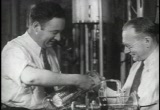

A Guided Tour Of Television’s First Studio…NBC’s 3H, 1939
A Guided Tour Of Television’s First Studio…NBC’s 3H, 1939
The things I have learned from NBC vets, and visits to 30 Rock, allow us to see this old video with new eyes. This is an RCA promotional film from 1939 designed to introduce television to the public and would have been broadcast on NBC during the Worlds Fair and shown in the RCA Exhibit at the fair and the RCA Exhibition Hall on 49th Street, next to 30 Rockefeller Plaza.
Before we start, here is some information that will help you get your bearings. This is something I learned while standing in the space that once was Studio 3H, but is now 3K.
Now, you enter the third floor studios from the main hallway in the building’s interior, but when this film was made, that hallway was mostly for tour groups. Engineers and talent used a different interior hallway (that was on the backside of the studios and against the building’s walls), to avoid the crowds. So, when you see the control room window, it will be on the back wall and is accessed from the fourth floor. The orchestra seen here will be directly under the visitor’s observation window, which faced the 4H control room window. The visitor/tour group window was also on the fourth floor which was accessed from the main hallways used for access today. If it seems confusing, I think seeing the video will clarify that.
At :49 we are at the RCA Labs in Princeton NJ where tube and camera tests are underway.
At 1:49 we see the antenna atop The Empire State Building and just after that, we see the transmitter room a few floors under it.
At 2:25 we see the new mobile units leaving 30 Rock and arriving at a horse race track for a live broadcast. This is a great sequence and gives us a good look at these trucks.
At 4:19 we finally enter Studio 3H. Watch closely! Notice the camera on the left has its top flipped up and the cameraman is making some internal adjustments. Notice on the right…the camera is rising. These pedestals had an internal electric motor to ped up and down. The cameraman with the rising pedestal is NBC’s first…Albert Protzman.
At 4:35 we see cameraman Don Pike on the Houston Fearless Panoram dolly. Don was NBC’s second cameraman.
At 4:44 we see up top, the visitor’s observation window on the fourth floor. This is the wall that opens into the main interior hallway that we use now. The smaller window below the 4H control room was the original 3H radio control room. Opposite this, at the main hallway end of the studio was a storage room which became a rear screen projection room.
At 4:51 we see the control room window. This is on the fourth floor and accessed by hallways on the back of the studios, against the exterior walls of the building.
At 5:04 the cameraman on the left is NBC’s great TD, Heino Ripp, on the right is NBC’s second cameraman Don Pike.
At 5:15 we see NBC’s first cameraman, Albert Protzman, manning the title card camera.
At 5:30, the broadcast starts. If the center camera were to tilt all the way up, we would see the visitor observation window. Behind the orchastra, would be the door to the 3rd floor hallway in today’s configuration.
At 5:57, notice the big tally lights under the camera lens (left and right of the cable). They are green. Before there were red tally lights, they used the green tally color to denote which camera was on the air.
At 6:17, notice the man on the far right. He is the director and as of late, I have identified him as William States who went on to be a technical director for the great Fred Coe. States later moved to Los Angeles and was a director at KTLA and can be seen there at this link https://eyesofageneration.com/january-1-1961-behind-the-scenes-at-ktla-the-rose-parade/
At 6:48 we get a look over the shoulder of the people in the control room looking out on the studio.
As the feature approaches the end, we go to the control room for a while. At the back desk, the director is in the foreground, closest to us. The woman is what was then called the production director who was mostly concerned with the script, runtime, cues and talent…today that would be an associate director. The man on the far end is what was then called the video engineer and is doing the switching…today we call this the technical director. At the front desk is the video man (closest) who is shading the cameras and on his right is the audio man.
Enjoy and share! -Bobby Ellerbee
Thanks Bobby!